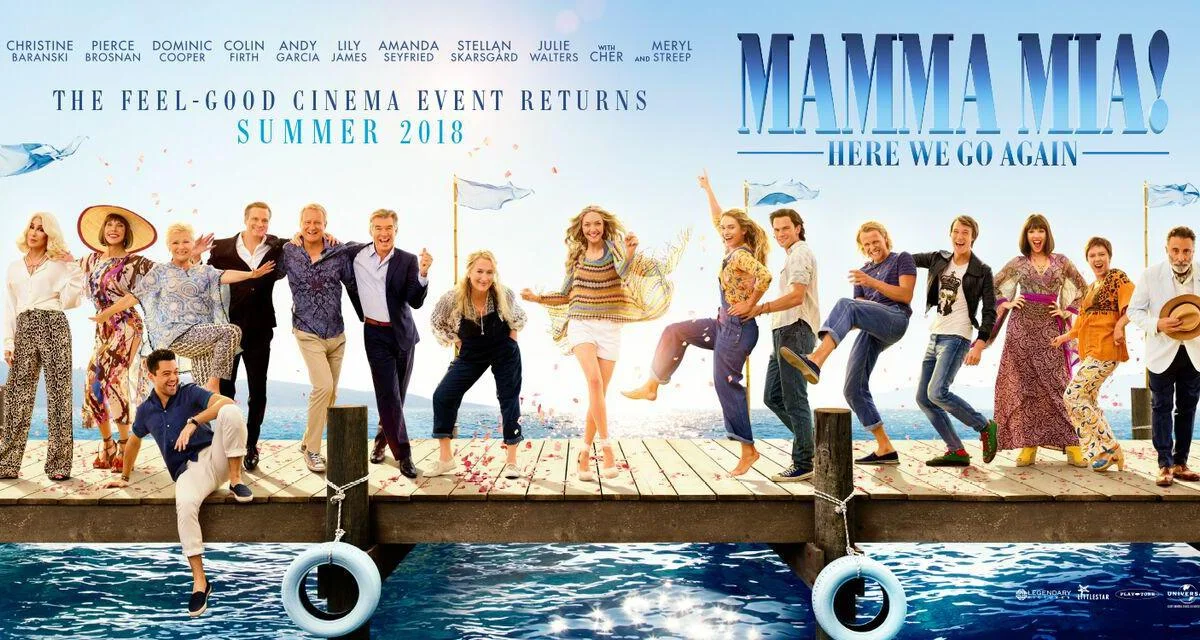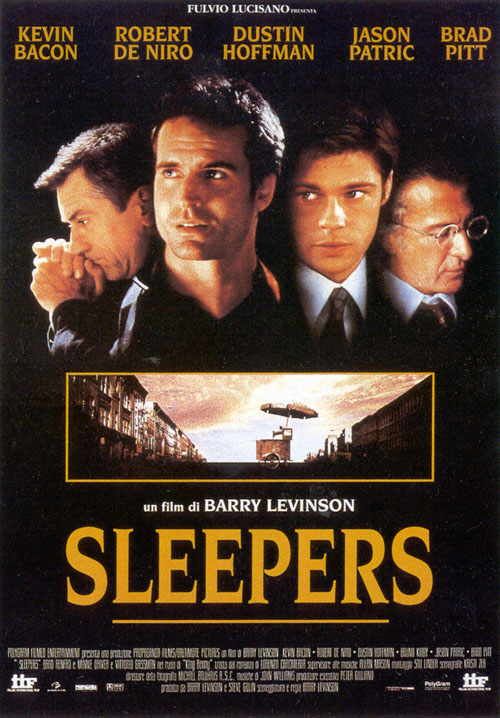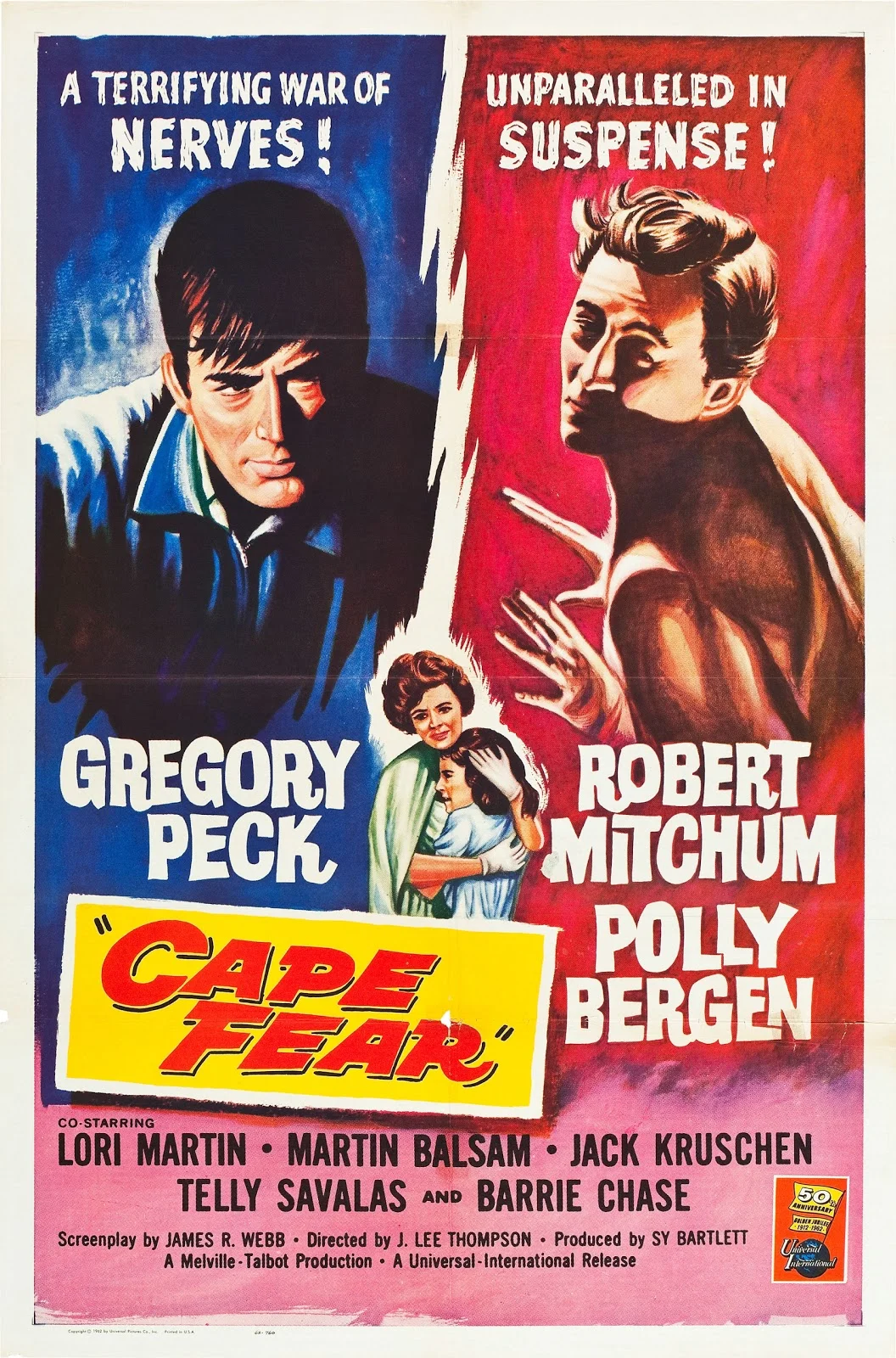Male Sexual Abuse Films (1996–2015)
Sleepers (1996)
C – 147m
Aspect Ratio: 2.35:1 – Widescreen
Novel: Sleepers by Lorenzo Carcaterra
Writer – Prod. – Dir.: Barry Levinson
Co–Prod.: Lorenzo Carcaterra
Starring: Kevin Bacon, Robert De Niro, Minnie Driver, Dustin Hoffman, Bruno Kirby, Jason Patric, Billy Crudup, John Slattery, Brad Pitt, Jonathan Tucker, Gerry Becker, Ben Hammer, Paul Herman, Lennie Loftin, Danny Mastrogiorgio, Mary B. McCann, Pat McNamara, Peter McRobbie, Mick O’Rourke, James Pickens, Jr., Wendell Pierce and Sean Patrick Reilly.
Music By: John Williams
After a prank goes disastrously wrong, a group of boys are sent to a detention center where they are brutalized. Over ten years later, they get their chance for revenge. Deliberately slowly paced but has great actors turning in great performances. The film is slightly over–long but the cinematography is impressive as are the aforementioned performances and an almost stellar script. There are a few lines that may invoke a, “No duh,” or other wised colored version of that statement from viewers. Period detail is fine and the soundtrack is fun. The indecision on a star rating is the fault of this reviewer. This reviewer can make arguments as to why this should just be a three star film but can also make arguments as to why it is the near perfect three and a half star film rating too. Rather than split hairs, this reviewer will cop to saying: flip a coin on it yourself after you have seen it and see where it lands for you. It does come highly recommended though!
Trivia: Film Critic Roger Ebert criticized this movie as, “homophobic.” During filming, the two younger actors who play the roles that would become Brad Pitt and Jason Patric, wore contact lenses so they would have the same eye color as Pitt and Patric. This movie was filmed at Fairfield Hills, a former psychiatric hospital in Newtown, Connecticut; right after the state took possession of the property. Billy Crudup and John Slattery, in addition to this film, appeared in Spotlight (2015), which also revolves around similar themes of abuse.
Oscar® nominated for: Best Original Score – John Williams.
Rated: [R] – Language, Graphic Violence, & Two Scenes Of Strong Sexual Content
Available on Blu–ray, DVD & Digital Copy
Mystic River (2003)
C – 138m
Aspect Ratio: 2.39:1 – Widescreen (Theatrical) / 2.40:1 – Widescreen (Blu–ray)
Novel: Mystic River by Dennis Lehane
Screenplay By: Brian Helgeland
Prod. – Dir.: Clint Eastwood
Starring: Sean Penn, Tim Robbins, Kevin Bacon, Laurence Fishburne, Marcia Gay Harden, Laura Linney, Kevin Chapman, Tom Guiry (as Thomas Guiry), Emmy Rossum, Spencer Treat Clark, Andrew Mackin, Adam Nelson, Robert Wahlberg, Jenny O’Hara, John Doman, Cameron Bowen, Jason Kelly, Connor Paolo, T. Bruce Page (as Bruce Page), Miles Herter, Cayden Boyd, Joe Stapleton, Tom Kemp, Bill Thorpe, Ken Cheeseman, Duncan B. Putney, Ed O’Keefe, Michael McGovern, Susan Bergeron (uncredited), Kevin Conway (uncredited), Brian Frates (uncredited), Eli Wallach (uncredited), Victor Warren (uncredited), Jillian Wheeler (uncredited), Brian A. White (uncredited) and Kris Williams (uncredited).
Music By: Clint Eastwood
The lives of three men who were childhood friends are shattered when one of them has a family tragedy. Heavy but powerful film focuses on the tight bonds of three guys who grew up in or around Southie, Boston. It adds to the enjoyment of the film if one is familiar with the area. Solid performances abound here and Eastwood masterfully handles the direction chore. The length may not be for all tastes but this reviewer doesn’t mind it. If one can look past the language, violence and thematic element of sexual abuse of a boy, there is a lot to be enjoyed here. The subtext is as rich as the plot and the characters. Good cinematography to boot… Dig the score composed and performed by Clint Eastwood too. A MUST for Boston or Boston area natives!
Trivia: The situation at the opening of this film is based on an incident when, as a child, author Dennis Lehane’s mother castigated him for getting into a car with two men who claimed to be plain–clothes policemen. The studio execs at Warner Brothers wanted Clint Eastwood to shoot this film in Toronto, Canada to save money. Eastwood refused and pushed to have the film shot in Boston where the story takes place. He won. Michael Keaton was originally cast as Sean Devine, played here by Kevin Bacon, and had already done several table reads with the principle cast and was well on his way in his research for the role with the Massachusetts State Police Department, when he got into a huge argument with Clint Eastwood. As a result of the argument, Keaton left the film and was replaced by Kevin Bacon.
This film was shot in 39 days. Forest Whitaker was the original choice for the role of Whitey Powers, played here by Laurence Fishburne, and he almost accepted the role but backed out due to other conflicts. Clint Eastwood narrated the teaser trailer. The liquor store scene was shot in Costello’s, a liquor store on Boylston Street in the Back Bay of Boston, next to Berklee College Of Music. After filming, screen shots from the scene were placed in the front display windows. Costello’s closed in January 2007. In the novel the surname of Jimmy and his family is Marcus but in the film it is Markum.
Oscar® winner for: Best Actor – Sean Penn and Best Supporting Actor – Tim Robbins. Additionally Oscar® nominated for: Best Picture – Robert Lorenz, Jodie Hoyt and Clint Eastwood, Best Supporting Actress – Marcia Gay Harden, Best Director – Clint Eastwood, and Best Adapted Screenplay – Brian Helgeland. Golden Globe winner for: Best Actor – Motion Picture – Drama – Sean Penn and Best Supporting Actor – Motion Picture – Tim Robbins. Additionally Golden Globe nominated for: Best Motion Picture – Drama, Best Director – Motion Picture – Clint Eastwood, and Best Screenplay – Motion Picture – Brian Helgeland.
Rated: [R] – Language & Violence
Available on Blu–ray, DVD & Digital Copy
Spotlight (2015)
C – 128m
Aspect Ratio: 1.85:1 – Widescreen
Writers: Josh Singer and Tom McCarthy
Exec. Prod.s: Jonathan King and Josh Singer
Dir.: Tom McCarthy
Starring: Mark Ruffalo, Michael Keaton, Rachel McAdams, Live Schreiber, John Slattery, Brian d’Arcy James, Stanley Tucci, Elena Wohl, Gene Amoroso, Doug Murray, Sharon McFarlane, Jamey Sheridan, Neal Huff, Billy Crudup, Robert B. Kennedy, Duane Murray, Brian Chamberlain, Michael Cyril Creighton, Paul Guilfoyle, Michael Countryman, Gary Galone, Nancy Villone, Joe Stapleton, Maureen Keiller, Laurie Murdoch, Richard O’Rourke, David Boston (uncredited), Richard Jenkins (voice, uncredited) and Colleen Kelly (uncredited).
Music By: Howard Shore
The true story of how The Boston Globe uncovered the massive scandal of child molestation and cover–up within the local Catholic Archdiocese, shaking the entire Catholic Church to its core. This is a splendid dramatization of the facts around the Catholic Church sex abuse scandal and how The Boston Globe uncovered it. While this may not technically be a thriller there is tension built during the film that will keep viewers on the edge of their seats. Wonderful acting by a colossal cast and a very impressive set of actors to be sure. The set on which parts of this film was shot is an achievement as well. While the subject matter may be a sore spot for some, or even unappealing or repulsive to others, the depiction of the victims of the abuse and their stories are handled with dignity and there is nothing graphically depicted here. While the purported numbers of abuse cases may be indeed huge, there are likely some minor embellishments, as is the case with most dramatizations. Should this wreck the film for you? Or even keep one from seeing the film? No. It works on too well to be ignored as a film. Watch it!
Trivia: The Boston Globe offices were all a big set. When Michael Keaton met the man he played in the film, he did an impression of him based on tapes he had watched of the man, etc. It was so good that it unnerved the real person Keaton played in the film. The guy was quoted as saying, “If Michael Keaton robbed a bank they would come and arrest me!”
Oscar® winner for: Best Picture and Best Original Screenplay – Josh Singer and Tom McCarthy. Additionally Oscar® nominated for: Best Supporting Actor – Mark Ruffalo, Best Supporting Actress – Rachel McAdams, Best Director – Tom McCarthy, and Best Editing. Golden Globe nominated for: Best Motion Picture – Drama, Best Director – Motion Picture – Tom McCarthy, and Best Screenplay – Motion Picture – Josh Singer and Tom McCarthy.
Rated: [R] – Some Language Including Sexual References
Available on Blu–ray, DVD & Digital Copy































